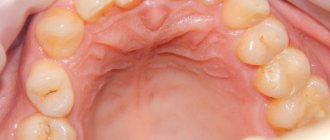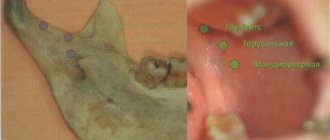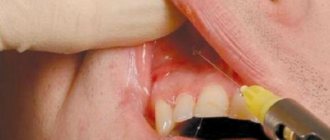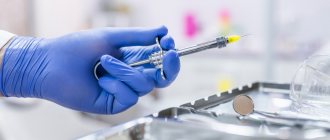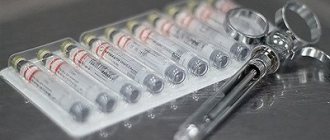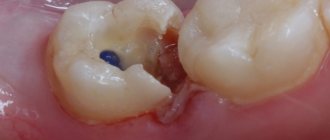- Operating principles
- Anesthesia methods
- Indications and contraindications
- Types of anesthesia
- pain relief in pregnant women
- Anesthesia for children
- Recommendations
- Complications
- Drugs used
- Price
Nowadays, it is possible to receive medical care not only fast and high-quality, but also painless. Almost any action of the doctor that can bring discomfort or unpleasant sensations to the patient is accompanied by dental anesthesia, or in other words, “freezing”. He stops experiencing pain and fear and relaxes, allowing the dentist to calmly do his job.
Operating principles
Anesthesia is carried out immediately before the start of treatment. The anesthetic comes in both liquid and gel form. The doctor injects into the soft tissues that are located near the diseased tooth. After some time, the tongue, gums and cheeks become numb and “freeze”. At this moment, the anesthetic acts as a blocker of nerve impulses that send a pain signal to the brain. The patient calmly endures dental procedures without experiencing stress.
The duration and effectiveness of dental anesthesia depends on the quality of the materials used and the location of the injection. The closer to the problem area the injection was administered, the more intense its effect. Each organism is individual, therefore the drug will be excreted at different rates.
Different types of drugs function in their own ways. For example, gel-like ones applied to the gums or surface of the cheek last only a couple of minutes. If they are installed in the upper part of the jaw, the effect will last for 2-3 hours. To treat the lower group of teeth, a deeper injection is required, so the result lasts up to 4 hours. After the solution is absorbed, the numbness disappears and sensitivity returns to the patient.
Computer anesthesia
How often do people avoid visiting the dentist simply because the fear of pain outweighs concern for their own health. Traditional anesthesia methods help avoid pain during treatment, but have some disadvantages:
- When an anesthetic is injected through a syringe, pressure is created, as a result of which soft tissue is injured, and swelling and hematoma occur in the injection area.
- It takes time for the anesthetic to take effect. As a rule, loss of sensitivity occurs within 10–15 minutes, but it can linger for half an hour.
- Conventional anesthesia causes numbness in the lips, tongue and cheeks, and deprives parts of the patient's face of sensation. The patient's diction is impaired, and there are frequent cases of biting lips, cheeks or tongue.
- When the effect of the anesthetic wears off, the patient begins to feel the consequences of injury to the soft tissues: for some time they will “ache” and remain swollen.
But even these can now be avoided.
We are proud that today we can offer you a new, modern, improved method of pain relief - computer anesthesia. You may be wondering: how can an injection be computerized? And what are the advantages of electronic pain relief over traditional injections?
The SleeperOne device is a small French miracle.
- Its main part, which replaces the syringe, is the tip. It looks like a regular writing pen. This form eliminates the “white coat” effect - the patient’s involuntary fear of a medical instrument.
- The SleeperOne handpiece is very comfortable to hold in your hands. If the doctor is forced to hold the syringe suspended, then with the new device he can find a reliable support point for the hand. This eliminates hand tremors and ensures high accuracy of the injection site.
- Special “Intralig-S” needles have a special structure - the tip of the needle has a patented double point, which penetrates the tissue without injuring it. Both points are optimized in diameter and length, which ensures easy and painless puncture.
- At the base of the needle there is an indicator of the optimal position. The doctor can easily position the tip in the best possible way. The needle does not bend or break. Leakage of anesthetic is excluded.
- And, finally, the most important thing is that the device provides an optimal uniform rate of anesthetic delivery, avoiding excessive pressure and overdose.
In the arsenal of Denta-Lux doctors there is an even more advanced device - the latest development of the French “Quick Sleeper” for intraosseous anesthesia.
This is the most effective and most reliable physician assistant in the field of pain management today.
The neurovascular bundle approaches the teeth through tubules inside the jaws. Bone tissue has a spongy structure that absorbs the anesthetic well. But the outside of the bone is framed by dense tissue - the cortical plate. It also poses an obstacle to medicine. Now dentists can inject an anesthetic behind this plate, directly into the bone tissue.
A special needle with an offset center and a beveled tip rotates around its axis under the influence of the device. It easily, painlessly and without damage penetrates beyond the cortical layer, to the cancellous bone. The entire process is programmed and fully controlled by the device. For example, if the needle moves, the system gives a warning signal. The doctor can only monitor the correctness of the given data.
In addition to the listed advantages of computer anesthesia, intraosseous administration of the drug has a number of additional advantages:
- soft tissues are not injured when administering the medicine
- Much less anesthetic is required for reliable pain relief
- One injection can numb several teeth
- The effect of anesthesia manifests itself much faster - within a few minutes
- There is no numbness of soft tissues - correcting makeup after treatment will not be difficult
The risk of error and complications is minimized. Patient comfort is maximum.
Denta-Lux dental holding strives to do everything possible to ensure that patients have only pleasant sensations from treatment. We really want you to tell your family, friends, colleagues, and neighbors: “You never dreamed of how they treat you there!” We try to keep up with the times and always offer you the best. At the same time, you do not have to choose between comfort, safety, quality of treatment on the one hand and the cost of medical services on the other.
The fear of pain is already a thing of the past. In the present - your snow-white and radiant smile!
Anesthesia methods
Depending on the goals and nature of the problem, the doctor chooses the method of pain relief. In medicine there are two main methods:
Anesthesia
It is most often used in surgery, and in dentistry much less often, in case of urgent need. It affects the entire body of the patient, inducing a state of sleep. At this time, all muscles relax and consciousness turns off. You can administer painkillers intravenously or inhale vapors through a mask. Deep anesthesia is used during complex operations when a person does not have enough strength to cope with pain or it is necessary to completely eliminate body movement. During sleep, the doctor monitors the patient's condition to avoid emergency situations.
Recovery from anesthesia is the body’s return to normal functioning after a long “freeze.” For all people, this process proceeds differently, some experience signs of nausea or a feeling of lethargy, while others wake up well-slept and rested.
General anesthesia in dentistry during pregnancy is applicable only in emergency cases when there is no other alternative.
Local anesthesia
Unlike anesthesia, it occurs locally, affecting only certain areas of the body. Can be used for children and pregnant women, without fear of unwanted consequences. In dental practice, this method is most often used, so we will talk about it in more detail.
Modern anesthesia in dentistry: contraindications for use
The main contraindication to anesthesia in dentistry is an allergy to its components; side effects should also be taken into account, which are most often associated with the presence of additional substances in the anesthetic solution: vasoconstrictors, preservatives and stabilizers. In particular, it is necessary to especially carefully select drugs for patients with cardiovascular diseases, arterial hypertension, and decompensated forms of endocrine diseases (diabetes mellitus, thyrotoxicosis, and others). To determine which substances a person has a negative reaction to, the doctor sends him to the Institute of Allergology to perform tests. In accordance with these data, a safe drug for local anesthesia is selected, and in case of reaction to all groups of anesthetics, general anesthesia is used.
Indications and contraindications for the use of local anesthesia
Any dental intervention that causes pain must be accompanied by “freezing” of the required area of the oral cavity. There is a list of diseases for the treatment of which it is necessary to administer anesthetic drugs:
- Complex caries;
- Removal of a tooth or its roots;
- Periodontitis;
- Inflammatory processes in the dental system;
- During prosthetics.
Before drawing up a treatment plan and choosing medications, the doctor must interview the patient and find out from him the presence of contraindications in order to exclude the possibility of complications.
- Allergy to drugs used;
- Heart diseases;
- Diabetes;
- Problems with the endocrine system.
About carpuled anesthetics, syringes and needles for local anesthesia
Dental centers, including ours, use not ampoule, but carpule anesthetics of the latest generations. The drugs are in special containers - cartridges, which are inserted into a carpule syringe. The thinnest disposable needles are used for syringes. Carpuled anesthetics are used by doctors taking into account pharmacological characteristics, including additives.
The carpule syringe is easy to use, allows you to take an aspiration sample, insert a needle and inject with one another. It can be easily sterilized in an autoclave, which is used by most dentists. Ease of use reduces the risk of intravascular injection and needle deviation in tissue from the chosen trajectory.
The needle is fixed using a thread of European or American standard. Naturally, all consumables are absolutely sterile, their tips are in excellent condition - sharpened and specially coated, making the injection less traumatic.
Advantages of anesthesia using carpuled anesthetics:
- Absolute sterility. The ampoule does not open, and therefore there is no contact of the solution with the air.
- Exact dosage. All drugs, including those that protect the anesthetic from decay, are in the required dosages.
- No pain. The needle of the syringes is thinner than regular ones and has a special angle and sharpening pattern, which reduces the pain sensation to almost zero.
Types of anesthesia
There are several methods in medicine; they differ in duration, effectiveness and location.
Conductor.
The most common type of local anesthesia in dentistry. Using a special needle, the drug is injected near the nerve trunk, blocking pain impulses that go to the brain. The injection is given in doses not exceeding a volume of 5 ml. To ensure a guaranteed result, the injection is placed at an angle of 90 degrees.
“Freezing” applies only to a certain group of teeth, in the place where the treatment will take place. After about 15 minutes, the medicine begins to work and the doctor can begin work.
The injection site can be additionally lubricated with lidocaine. If during the procedure the patient continues to feel discomfort, another dose may be administered.
Infiltration
It differs from the conductor only in the angle of the needle and the place of application. The drug is injected directly into the root apex area. This type is most effective for teeth and upper jaw. With infiltration anesthesia, you can “freeze” both a small area and a large surface of the oral cavity along with soft tissues.
Applique
This method is performed without a syringe. The dentist applies the necessary product directly to the diseased tooth and the soft tissues surrounding it using a cotton swab or fingers. Some doctors spray anesthetics using a special spray.
It is mainly used during simple and quick operations, since its effect is short-term and does not protect against severe pain. The result is stored for a maximum of 20 minutes. It is often used as the first stage before the injection “freezing” method.
Intraosseous
The dentist resorts to this technique much less often when other types of anesthesia have proven ineffective. An analgesic that is injected directly into the hard tissues between the teeth. The difficulty lies in the technique; to get to the bone, the doctor cuts the gum and drills a hole in it with a bur. This is the most effective method for quickly and permanently freezing the required area.
Intraligamentary
Its peculiarity is the high speed of injection, so numbness occurs almost immediately, but lasts only 20-30 minutes. The advantage of intraligamentary anesthesia in dentistry is that it acts directly on the tooth without touching the cheeks, lips and tongue. That is why the recovery process is much easier.
Infiltration anesthesia
The computer-controlled flow rate of the anesthetic solution makes conventional infiltration anesthesia more effective, predictable and comfortable for the patient (Fig. 5).
Rice. 1-5. STA technology is indicated for: anesthesia of the anterior and middle superior alveolar nerve (1), the anterior group of teeth of the upper jaw - from canine to canine (2), as a primary method of anesthesia (3), for anesthesia of the inferior alveolar nerve (4) and as conventional infiltration anesthesia (5).
Features of pain relief in pregnant women
One of the most common misconceptions is that pregnant women are contraindicated for dental treatment. You should not trust unreliable sources; dentistry and pregnancy are completely compatible concepts. Expectant mothers should undergo a professional examination during planning and at 8, 18 and 28 weeks of pregnancy. Untreated infections in the oral cavity contribute to the development of other dangerous diseases.
The question immediately arises: can the use of dental anesthesia harm the health of the unborn child? Modern technologies allow the use of drugs with lower concentrations of adrenaline. Accepted painkillers are ultracaine, primacaine or mepivacaine*. They do not penetrate the placenta, therefore, do not harm the body of a pregnant woman.
*A verified and accurate list of acceptable medications can be obtained from your doctor.
Anesthesia for children
Painless pediatric dentistry is a hot topic today. All parents know what a trip to the dentist means for a child. If this brings few pleasant emotions to an adult, then what can we say about children. The first scheduled visit is always scheduled for the age of 6-7 years - this is the time when baby teeth are replaced with permanent ones.
The psyche of children is not yet fully formed; one wrong word or action can provoke the development of unpleasant memories. Therefore, it is important to instill confidence in the child, to mentally prepare him for the procedure: explain why he is going there and what the doctor will do. The use of anesthetic agents in pediatric dentistry is an integral part of comfortable treatment.
The most suitable injection methods for babies are infiltration, conduction and application. The place where the drug is administered is “frozen” in advance and only then does the doctor give an injection. The child’s body is not yet fully formed, so in pediatric anesthesia, special medications are used that make it possible to carry out the procedure safely.
Recommendations
For the successful use of anesthetics, there are two conditions: 1) the patient must abstain from drinking alcohol at least 24 hours before treatment; 2) feel good.
Often, after the effect of painkillers wears off, the patient experiences pain, swelling, tingling at the injection site, and difficulty opening the mouth (trismus). Within 2-4 days, all residual effects should disappear.
After treatment, sensitivity returns gradually, so take the food carefully so as not to accidentally bite yourself. It is also recommended to quit smoking during this time.
Ultracain DS
The analgesic basis of the first two drugs is ARTICAINE (amide anesthetic from the thiophene series), an antispasmodic - lowers blood pressure. It is characterized by rapid action - anesthesia occurs in 0.5-3 minutes. Articaine is 2 times stronger than lidocaine and 6 times stronger than novocaine (anesthetics of previous generations), less toxic, relatively quickly eliminated from the body. Its half-life is, on average, 22 minutes, that is, all traces of the drug disintegrate in 44 minutes and are then completely eliminated from the body. Has high penetrating ability. It is distinguished by high purity of the solution. Allergic reactions to articaine are very rare - one in one hundred thousand injections ; the use of articaine, according to studies, is safe in 99.4% of cases. They also contain a vasoconstrictor (a substance that causes constriction of blood vessels and a decrease in blood flow in them) - adrenaline. The use of a vasoconstrictor continues and enhances anesthesia. The drug also contains antioxidants (sulfites) - substances that prevent the oxidation of adrenaline.
Ultracaine does NOT contain parabens (anesthetic preservatives), which significantly reduces its toxicity. In addition, parabens can cause allergic reactions.
Thus, ultracaine is:
- a strong anesthetic with moderately low toxicity, due to its components;
- the safest drug for pregnant women, because articaine does not penetrate the hematoplacental barrier - the barrier separating the blood of the fetus and the blood of the mother (Ultracaine DS).
School-age children can also use Ultracain DS. We always remember that the administration of an anesthetic solution with adrenaline is CONTRAINDICATED for children under 5 years of age, patients with pathologies of the cardiovascular system, with endocrine pathologies, taking antidepressants, thyroid hormones, drugs that block beta adrenergic receptors; - an anesthetic that practically does not require postoperative pain relief;
- a drug that provides a rapid onset of anesthesia, depending on the anesthesia tactics chosen by the doctor, the effect occurs within 30 seconds to 3-5 minutes);
The duration of anesthesia is, depending on the technique chosen by the doctor, from 1.5-2 hours to 5-6 hours. The choice of different techniques (infiltration, conduction anesthesia) depends on the planned dental procedure. For example, there is a difference between the treatment of caries of one tooth and the complex removal of a wisdom tooth. - good local and general tolerability. According to studies, only 4.3% of patients experienced toxic reactions, which was caused by the presence of adrenaline and sodium disulfate in the anesthetic solution.
- For standard procedures, a small amount of anesthetic is required (0.9 ml-1.8 ml).
I would like to note that for standard dental operations it is better to use Ultracain DS (adrenaline 1:200,000). A strong anesthetic provides high-quality anesthesia even during complex, long-term interventions, and a small amount of vasoconstrictor ensures low toxicity of the anesthetic solution. And we prefer to consider Ultracaine DS forte (adrenaline 1:100,000) as a “reserve anesthetic” in more complex situations:
- anesthesia of the lower lateral teeth (molars) for their treatment and depulpation;
- pain relief for inflammatory processes in the maxillofacial area (periostitis, osteomyelitis);
- for particularly traumatic interventions;
- in patients with a low pain threshold.
